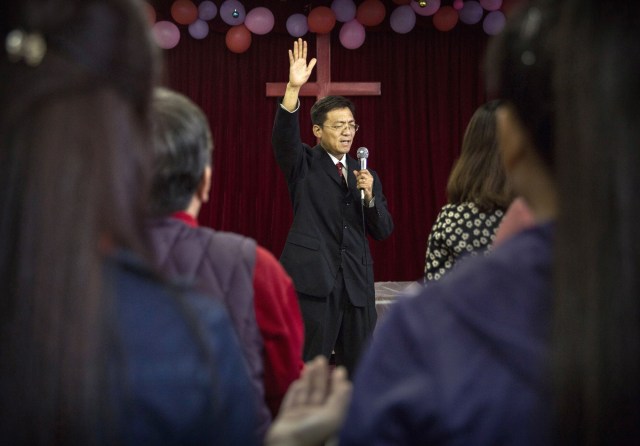Credit: Kevin Frayer / Getty

The Chinese state formally recognises – and attempts to regulate – five religions: Taoism, Buddhism, Islam, Catholicism and Protestantism. It is interesting to see the last two treated as separate religions, but then the Chinese state is more interested in control than Christian unity.
Catholicism has long been seen as a special challenge, because the Roman Catholic Church is a global organisation with priests and bishops under the authority of a foreign leader. Hence the establishment of the China Patriotic Catholic Association as an organisational structure controlled by Beijing not the Vatican.
The equivalent body for Protestants is the Three-Self Patriotic Movement. The three ‘selves’ are not a reference to the Holy Trinity, but stand for self-governance, self-support and self-propagation – which, again, is all about cutting off religion in China from foreign influence.
With Xi Jinping clamping down on real and perceived sources of dissent, China’s Christians have not been spared. While the oppressive methods used to ‘re-educate’ Muslim Uighurs in China’s far west have been making headlines over here, the state is waging a much broader campaign of ideological conformity.
Consider the following from Jonathan Tam for Asia Dialogue:
“China continues to try to control Protestantism domestically. The official plan laid out by the China Christian Council and Three-Self Patriotic Movement on 28 March 2018 for the ‘Sinicisation of Christianity’ involves attempting to make Protestantism more patriotic and reflective of China’s history and culture over the next five years. While the general destination is set, it remains unclear what a ‘Sinicised’ form of Christianity would look like precisely.”
I’m not sure that the Chinese Communist Party is in the strongest of moral positions to preach about China’s history and culture, given how much of it they destroyed during the madness of the Cultural Revolution. It’s also worth noting that Christianity has been in China a lot longer than communism. In fact, the Church of the East reached China in the 7th century.
These days, most westerners have never heard of this ancient branch of Christianity – or else they confuse it with the Orthodox Churches of countries like Greece and Russia. It is, in fact, the result of a much earlier schism in the 5th Century, after which it spread eastwards into Persia and beyond, whereas what we think of as mainstream Christianity went broadly westwards into what was the Roman Empire.
The fortunes of these two early wings of Christianity greatly diverged – and today only a few fragments the Church of the East remain. Nevertheless, its history is a reminder that Christianity is not intrinsically western, let alone European.
That said, in more recent times, it was western missionaries who reintroduced Christianity to China. One could also argue that Protestantism is Christianity at its most western – and that its emphasis on the believer’s personal relationship with God is the spiritual foundation of western individualism and, therefore, liberalism. Of course, there are other facets to the multi-stranded Protestant tradition – for instance the strong collective identities of groups like the Amish.
Protestantism is also organisationally and culturally adaptable. Churches that were planted in, say, Africa by starchy Victorian missionaries have remained Christian (often fiercely so) but have become thoroughly African.
The question, therefore, is not whether Chinese Protestantism will ‘Sinicise’, but whether it does so along the lines desired by the government – and which it appears increasing determined to impose.
Jonathan Tam questions whether the state can succeed. To build “a Sinicised Version of Christianity, effectively from scratch”, he says, requires both “time… and an active intellectual community”. He argues that the state does not have enough of either at its disposal:
“China does not have a monopoly over the development of a Chinese version of Christianity. There are two major competitors. The first of these are the foreign seminaries and universities in the West that are currently developing increasingly globalised and cross-cultural theologies…
“The second competitor is ethnic Chinese seminaries, the number of which is growing within the Chinese diaspora in countries like America and Canada. In addition, Hong Kong, Taiwan and Singapore serve as Chinese intellectual hubs that maintain a fair degree of academic autonomy. As a result, the overseas Chinese have already been developing their own brand of Chinese Christianity, interlaced with their Chinese identity.”
If it can’t exert enough influence, will the government opt for outright persecution instead? We may not see Chinese Christians herded en masse into re-education camps, but policy instruments such as the Social Credit System could make life very difficult for non-conformists of whatever kind.
Perhaps Xi Jinping will look to the West for a different solution. If communism can’t check Christianity, then perhaps rampant materialism will do the job instead.










Join the discussion
Join like minded readers that support our journalism by becoming a paid subscriber
To join the discussion in the comments, become a paid subscriber.
Join like minded readers that support our journalism, read unlimited articles and enjoy other subscriber-only benefits.
Subscribe